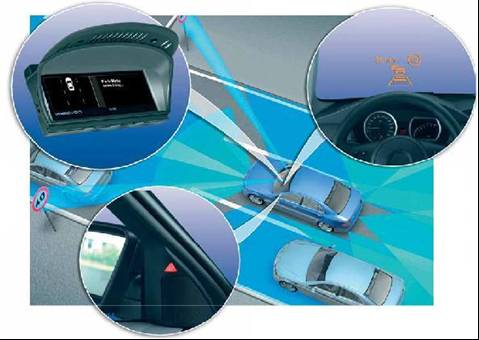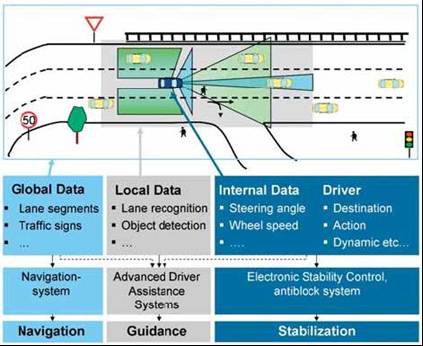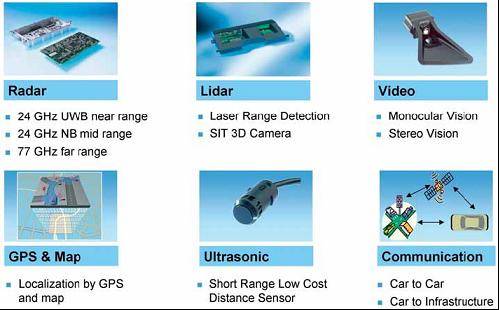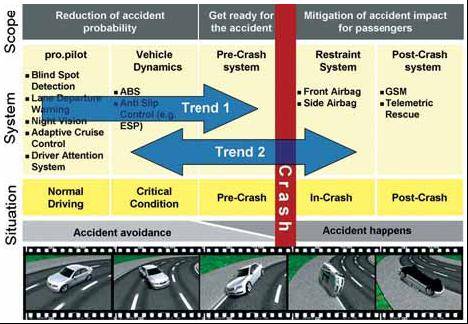The interaction between drivers, vehicles and systems is currently a challenge for Advanced Driver Assistance Systems (ADAS). Siemens Siemens VDO Automotive is meeting this challenge by applying the pro.pilot steering guidance system.
Drivers face very complex traffic conditions while driving. First, the driver needs to control the car's power. Second, they also need to keep an eye on the environment around the car. Third, the driver also has to specify the navigation route from the starting point to the destination. In addition, the driver may also use the in-vehicle infotainment system or chat with the passengers. The driver assistance system helps the driver to monitor and process information on three levels of stability, control and navigation (as shown in Figure 2), which will reduce the driver's workload and improve handling convenience and driving safety. . Anti-lock braking systems and vehicle stability control systems have been able to accomplish tasks at the automotive stability level. The navigation system can meet the needs of the navigation level and is more and more widely used. In the immediate environment of a car, the driver needs to guide the vehicle to stay in the lane. For example, drivers need to monitor other lanes, such as pedestrians, vehicles and cyclists, while also paying attention to the traffic signal and lane markings, and respond accordingly.

Figure 1 Advanced driver assistance system increases driving comfort and safety
Advanced driver assistance system
At present, the driver still relies mainly on his sensory stimulation to make judgments. In the past few years, as the number of cars has increased, the traffic conditions on the road have become more complex, which requires drivers to have the capabilities of sensors, controllers and brakes. The advanced driver assistance system uses a variety of sensing technologies to sense the surrounding environment and intelligently integrates global and internal data. The system can effectively increase the comfort and safety of driving, and support the driver's driving control. This will significantly reduce the number of traffic accidents, as seen by the American Association of Highway Safety (NHTSA) and the United States and international associations such as the European Union.

Figure 2 Data support and information assistance system
Pro.pilot network
In order to obtain the maximum benefit from the advanced driver assistance system and achieve the goal of “zero accidentâ€, the pro.pilot developed by Siemens VDO Automotive is driver-centric. In addition to increased safety and comfort, the pro.pilot provides drivers with more direction options and current overall traffic conditions, allowing drivers to choose a more economical driving solution. In this way, pro.pilot can help the driver in an emergency, but it does not reduce driving pleasure. But the driver still has to take all the responsibility for the car. The performance of environmental sensing and sensor technology is only one aspect of the success of advanced driver assistance systems. In addition to electromechanical components such as sensors and brakes, pro.pilot also includes vehicle integration, application and drive interfaces, as shown in Figure 3.

Figure 3 composition of pro.pilot
Vehicle integration includes both mechanical and electronic factors, such as sensors and brakes that need to be integrated into the structure and electronics of the car. Since the sensor is typically mounted around the surface of the vehicle, there are many limitations in design and packaging. The design and installation location of the drive feedback display is influenced by the overall automotive interior design. Adding components and controllers can affect the overall electronic system of the car, such as the number of ECUs, internal connections, bus bandwidth, delay time, and so on.
The application includes algorithms and software that can process and analyze the data obtained by the sensor to obtain a schematic representation of the environment surrounding the vehicle and classify traffic conditions. By detecting the target object, the driver can get a notification or warning in time to finally intervene in the power of the car. Human Machine Interface (HMI) can include visual, audible or tactile feedback. The communication between the driver and the system affects the performance of the entire system, including the impact on the driver and the vehicle, thus determining whether the advanced driver assistance system can reduce the occurrence of accidents.
With all of the above factors in mind, it is possible to specify the concept of a driver assistance system and use the right solutions and components to achieve a perfect high performance system.
ADAS sensor
The advanced assisted driving system is based on different sensor technologies, as shown in Figure 4. The 77 GHz radar sensor has been used for many years on the Active Cruise Control System (ACC) on high-end luxury cars. The system's sensors measure the speed of the vehicle ahead and the distance between the two vehicles, while monitoring the speed and spacing of the vehicle. Airborne Lidar sensors, which are currently in use in the mid-size sedan and economy sedan markets, are economical options for remote sensors. Compared to radar, this sensor emits laser pulses and detects light reflected from other objects. The interval with other objects can be calculated by the time the signal is delayed.

Figure 4 important sensors
The short-range radar sensor operates at 24 GHz and is used to monitor objects around the vehicle. Such sensors are typically mounted on the side of the vehicle and their information is used for blind spot detection (BSD) and line-assisted (LCA) functions, such as alerting the driver when an object appears in a blind spot or when a neighboring lane enters a blind spot. In the next step, its information can be combined with the navigation system to better achieve vehicle guidance. A 24 GHz radar sensor mounted in front of or behind the vehicle can be used to prevent collisions.
Video sensors are capable of monitoring image information such as the size and shape of side objects. Video sensors can monitor other road users, traffic numbers, and road signs. The information sent by the sensor enables lane departure warning and traffic signal identification.
Information on other infrastructure such as traffic numbers, turns, or hillsides can be obtained by mapping. Ultrasonic sensors are used in low speed situations, such as parking, while not requiring a high detection range. And internal data can be collected and made available to other vehicles. The traffic density is monitored by car-to-car communication data transmission.
In addition, data obtained through different sensors can be fused to each other to increase system functionality or enhance existing functionality. For example, the integration of radar, camera and airborne lidar with navigation data is important to improve vehicle performance. By combining the information from the camera and the map, the recognition rate of the traffic identification system can be improved. The detected traffic numbers are compared to eHorizon's data, and eHorizon can support the capabilities of ADAS by providing road infrastructure specific information based on navigation data. Calculating the confidence level will determine which traffic number to display to the driver. The fusion of these sensors also gives them a new feature, the SensiTIve Guidance, a navigation system that incorporates a radar or camera system. The output of the navigation system is adapted to traffic conditions, radar or camera sensors, such as monitoring vehicles in blind spots or other lanes.

Figure 5 Active and passive safety: future trends
Whether driving normally or driving in a hazardous environment, most driver assistance systems on the market today provide additional information to help drivers, as shown in Figure 5. In both cases, the system can help reduce the occurrence of collisions. There are two trends in the future of advanced driver assistance systems:
Trend 1: There have been some changes from the early warning system to the intervention system. ADAS's current main responsibility is to alert drivers in critical situations, such as blind spot detection systems. In the future, the system will evolve to an intervention system that controls the car under limited conditions. For example, the camera system will evolve from the lane departure warning system to the lane control system.
Trend 2: Combine active and passive safety systems. Currently, passive safety systems in collisions are independent of active safety ADAS, such as airbags and pre-shrinkable seat belts. There is no interconnection between them, such as airbags being prepared when airborne lidars, radar or video sensors detect inevitable collisions. The current airborne lidar sensor is used in an active cruise control system to provide support for drivers under normal driving conditions. In the future, these sensors will be combined with short-range radar (24 GHz) and cameras to provide appropriate information for airbags and pre-shrinkable seat belts.
Complete collision prevention system
These trends will make the collision prevention system more complete. The system can detect the inevitable collision accidents by monitoring the environment around the vehicle by using various sensor technologies. In the event of a collision, the system intervenes in the dynamic performance of the vehicle (eg braking) and pre-triggers the passive safety system. This development trend means the integration of brakes, controllers and sensors in the vehicle. The development and implementation of such an ADAS system also requires consideration of the following factors: synergy, convergence, structure, and system.
If a sensor can only implement one function, it is difficult to get a more cost-optimized solution. For example, camera performance can provide data for composite functions, such as monitoring road signs, traffic numbers, and other road users. The collaborative function allows the system to easily increase the functionality by adding some software. If composite sensors are applied to a car, the data provided by these sensors can be fused together. This will enrich the information for the target and make the results of the detection more credible. In collision prevention systems, this increase in detection reliability makes system intervention and early warning easier and more effective. The use of composite sensors in vehicles has a major impact on the structure of the vehicle, such as the addition of electronic control unit ECU performance. Therefore, the vehicle should be treated as a complete system that is a collection of various components that interact with each other.
In order to achieve these development trends, Siemens VDO Automotive has participated in many international and domestic cooperation projects. The goal is to ensure traffic safety by combining a complete system approach. The safety system will support drivers in a variety of traffic situations, from normal driving to latent inevitable collisions. Safety systems include traffic classification, risk assessment and action concepts.
to sum up
In the past few years, the market for advanced driver assistance systems has begun to flourish. Currently, comfort-oriented systems (such as ACC) are mainly used in mid-level or luxury cars. In the future, these systems will be covered in safety systems and used in economy cars.
However, the development of advanced driver assistance systems should not be seen merely as a technical issue, including many of the effects with drivers and the impact relationship with vehicle structures. This makes the approach to system requirements very complex and important. Siemens VDO Automotive sees itself as a system integrator through the pro.pilot network, meeting challenges more effectively.
A Ceiling Fan is a mechanical fan that is mounted on the ceiling of a room or space, usually electrically, and suspended from the ceiling of the room, using central mounted rotating blades to circulate air. Ceiling fans are more popular than ever in homes around the world. Ceiling fans are the best choice for any room and can benefit from more air flow, keeping you cool and more comfortable on hot summer nights. At the same time back to the bedroom to vacate more space. Ceiling fans are also useful in kitchens, greenhouses, living rooms and dining rooms.
Industrial Ceiling Fans,Bedroom Ceiling Fans,Lowes Outdoor Ceiling Fans,Best Outdoor Ceiling Fans
JIANGMEN LEDERLIGHT LIGHTING Co.,LTD , https://www.lederlightcn.com